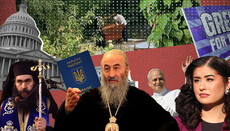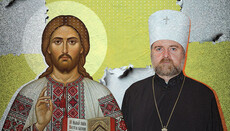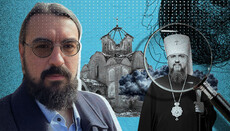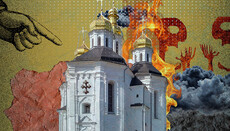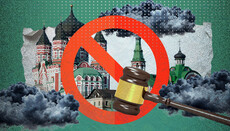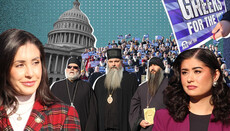Catholic children of Phanar in Ukraine: revelations of the UGCC head
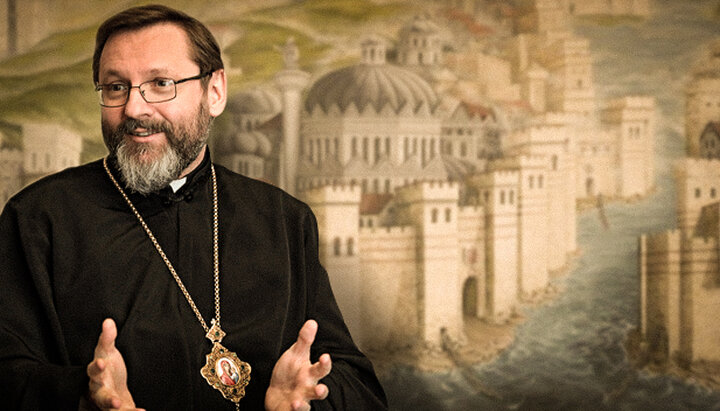
Shevchuk said UGCC received faith and theology from Constantinople in 988, and the union arose due to the occupation of Ukraine by Protestants. We analyze if this is so.
On November 21, 2021, the Brazilian newspaper "Gazeta do Povo” published an interview with the head of the UGCC Sviatoslav Shevchuk. The official website of the UGCC did not even dare to translate this interview from Portuguese into Ukrainian, limiting itself to an English translation. What did the leader of the Ukrainian Catholics of the Orthodox rite say to the Brazilians?
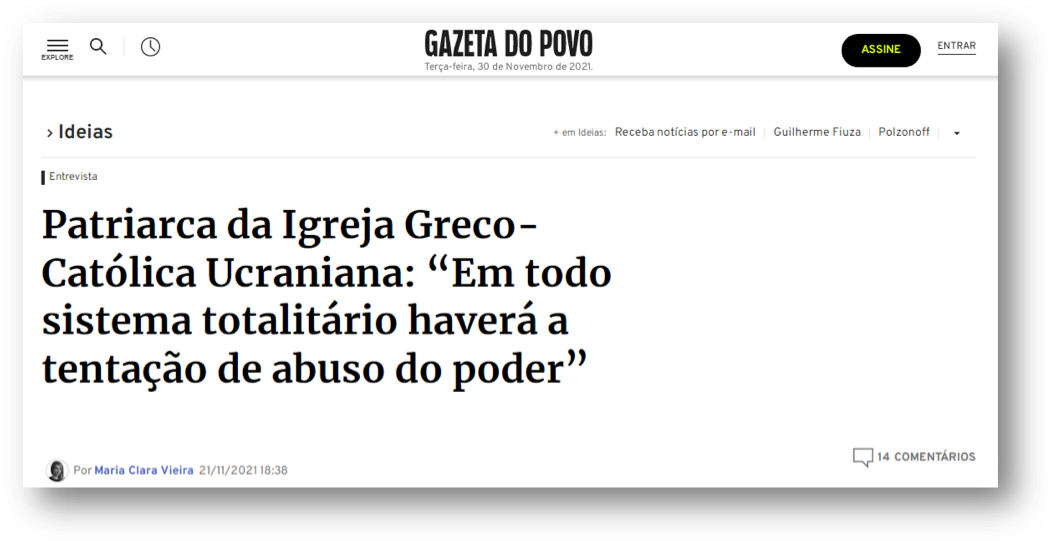
Patriarch or not?
Interesting is the title of the article, in which Sviatoslav Shevchuk is called the “patriarch” of Ukrainian Greek Catholics. This title appears both in the original Portuguese interview and in the English translation of it on the UGCC website: "Patriarch of the Ukrainian Greek Catholic Church ...". However, in reality, Shevchuk is not a patriarch; the Roman curia does not recognize such a status for the head of the UGCC. Since 2005, by the decision of Pope Benedict XVI, its head bears the title “His Beatitude Supreme Archbishop of Kyiv-Galicia". However, Sviatoslav Shevchuk, like almost all of his predecessors, is seeking from the Vatican the status of patriarchate for the UGCC. In the meantime, there is no result, and the head of the UGCC calls himself the patriarch and gives the appropriate instructions to his entourage and the Uniate media. In July 2019, it seemed this method would work, and the Vatican would finally grant Shevchuk the coveted patriarchal status. Pope Francis unexpectedly invited the hierarchs of the UGCC to the Vatican. On the eve of his visit to Rome, the Ukrainian media circulated the thesis that Sviatoslav Shevchuk was going to the Vatican for nothing more than “the patriarchate,” although he himself expressed his hope for this in more restrained wording. But this issue was not even discussed.
But Shevchuk's expectations were not unfounded. Immediately after the formation of the OCU, the topic of uniting this religious organization with the UGCC arose. The leaders of the two denominations met, agreed on cooperation and even started talking about unity. In an interview with the "Glavkom" edition dated January 9, 2019, Shevchuk said: "Everything must be done to restore the original unity of the Kyiv Church in its Orthodox and Catholic branches." To seize the leadership in this union, the Uniates desperately needed the status of patriarchate. Here are the words of S. Shevchuk said by him in May 2019 in Philadelphia: "We should build a patriarchate and reach out to our Orthodox brothers for unity."
In fact, Sviatoslav Shevchuk has spoken of his religious structure as a patriarchate, only not yet recognized by the Vatican. Before his Rome in 2019, in an interview with the Uniate resource “RISU”, he said: “We function as a patriarchal Church. <...> Therefore, we say that a patriarchate is being built, it is not granted, but it is recognized. From our side, we are doing everything to function as a patriarchal Church. And the issue of recognition (not creation or proclamation) is a question that belongs to the decision of the Ecumenical Bishop, and we respect the freedom of his decision."
The "Ecumenical Bishop", that is, the Pope, decided not to grant the status of patriarchate at that time. Most likely, the reason is unfulfilled expectations from the OCU project. When Zelensky became president, and the state support for this structure weakened, the growth of the OCU also stopped. It became clear that it would not become the country's main denomination. In such a situation, there was no need for the UGCC to pedal the topic of unification with the OCU, which means there was no point in giving the Uniates the status of patriarchate.
But today the situation is changing. OCU is again in favour with those in power. The Ukrainian leadership visits Phanar and receives its head. Prime Minister D. Shmyhal declares all kinds of support for the OCU, including financial one. In addition, the ecumenical contacts between the Vatican and the Phanar have reached a new level. From both sides, there are statements about the imminent unification of the two confessions. Therefore, the topic of the unification of the UGCC with the OCU, and, consequently, the acquisition of the status of patriarchate by Ukrainian Uniates, has become relevant again.
UGCC: Catholics or Orthodox?
The statements that Sviatoslav Shevchuk (as incidentally other Uniates) addresses to this or that audience, one can trace a striking ambiguity. So, for the Ukrainian audience, the UGCC is presented as an "Orthodox" Church or, as it is now fashionable to say among the Uniates, "the Church of Vladimir's Baptism". At the same time, unity with the Vatican is obscured or even denied.
For the Ukrainian audience, the UGCC is presented as an "Orthodox" Church or, as it is now fashionable to say among the Uniates, "the Church of Vladimir's Baptism". At the same time, unity with the Vatican is obscured or even denied.
For example, in 2012, during a visit to Donetsk, Sviatoslav Shevchuk said: "We are a Church in which there is an Orthodox tradition, ritual, liturgy, Orthodox dogmatic theology."
In 2018, during the “rite of hierarchical naming” of one of the Uniate hierarchs, Sviatoslav Shevchuk said: “The Ukrainian Greek Catholic Church is the Church of Vladimir's Baptism, which has been and will be the soul of the Ukrainian people <...> This is part of the faith of Prince Vladimir’s Church <...> We are not members of the Latin Patriarchate."
Statements similar in meaning are often heard from the lips of the head of the Ukrainian Uniates. The narrative that the Uniates broadcast to the internal Ukrainian audience is as follows – we are the same Orthodox, like the rest of the Orthodox, we are simply in unity with the Pope.
In messages to foreign audiences, the rhetoric changes dramatically. Below are the quotes from S. Shevchuk's interview to “Gazeta do Povo”:
- Today, we are more than 5 million Ukrainian Catholics inside and outside Ukraine.
- Outside Ukraine, even in Argentina and Brazil, our correct name is Ukrainian Catholic Church.
- We Catholics – Byzantines or Romans –…...
As you can see, the narrative is different – we are the same Catholics as other Catholics, we just keep the Byzantine rites. That is, Shevchuk is not talking about any Orthodox dogmas.
Addressing a foreign audience, Shevchuk claims that in the UGCC there are the same Catholics who simply preserve Byzantine rituals.
Taken together, these two mutually exclusive narratives give the thesis, which is now actively promoted by both the Phanar and the Vatican: you can be a Catholic and Orthodox at the same time, the differences between Orthodoxy and Catholicism are insignificant, they relate only to certain theological subtleties that ordinary people do not care about at all and also historical conflicts that can be overcome.
S. Shevchuk declares it this way: “We still retain as our fundamental mark of the Church's identity, even though we are in full communion with the Holy Pope Francis.”
However, such words are nothing but a lie. The lie that will remain a lie until the Pope repents of all the heretical errors that Catholicism adheres to. Until this happens, it is impossible to retain the Byzantine tradition, by which S. Shevchuk undoubtedly means the Orthodox tradition, and to have communication with the Latins.
No matter how S. Shevchuk, Pope Francis or Patriarch Bartholomew assured us, the difference between Orthodoxy and Catholicism is enormous, and it concerns the fundamental moments for the salvation of the human soul. More details about these differences can be found in the article "What's Wrong with Catholics", and in short, they are as follows:
- the procession of the Holy Spirit from the Father and the Son, which means belittling the Divinity of the Holy Spirit;
- the statement that the Pope is the visible head of the Church, which means the elimination of headship of Jesus Christ in the Church;
- perversion of the understanding of the essence of salvation: instead of Christ healing the damaged human nature, man simply gets rid of punishment;
- the dogma of the Immaculate Conception of the Virgin, which means that the Most Holy Virgin did not need the Saviour;
- the dogma of purgatory, which perverts the original teaching of the Church about the posthumous fate of the dead;
- a practiced method of sensual prayer, which is strictly forbidden by Orthodox ascetics and is called delusion;
- a statement about dogmatic development, which allows you to introduce new dogmas and reinterpret the old ones at your own discretion.
Catholicism is fundamentally incompatible with Orthodoxy, and all talk about the possibility of being a Catholic with a "Byzantine identity" is deliberate speculation to deceive the Orthodox.
All this allows us to assert that Catholicism is fundamentally incompatible with Orthodoxy, and all talk about the possibility of being a Catholic with a "Byzantine identity" is deliberate speculation to deceive the Orthodox and convince them of the possibility of unification with Rome. To hammer into people's minds the idea of the possibility of such a unification, the Uniates do not stop even before an open distortion of historical facts.
The history of UGCC turns out to have begun in 988
Let's go directly to the revelations of the UGCC head to the Brazilian edition.
S. Shevchuk: “The history of our Church began in 988, when the prince of Kiev decided to accept Christianity not only for himself, but for the State. This happened before the Great Schism between West and East, which resulted in the birth of the Catholic and Orthodox Church."
First, the history of the Ukrainian Uniates does not begin in 988 when Russia was baptized into Orthodoxy, but in 1596 when two Ukrainian bishops, Cyril (Terletsky) and Hypatius (Pociej), went to Rome and betrayed the Orthodox faith, as a sign of which they took an oath of allegiance to the Pope and kissed his shoe.
Secondly, S. Shevchuk deliberately manipulates the fact that the schism between Orthodoxy and Catholicism dates back to 1054. However, everyone knows that the main errors of Catholicism took root in the Latin Church several centuries before, and the events of 1054 only formalized the break in communion. At the end of the 10th century, Orthodoxy and Catholicism were already perceived as two different identities (in the language of S. Shevchuk). This is evidenced by the fact that St. Prince Vladimir made a choice between Orthodoxy and Catholicism, and also Judaism and Islam. It should also be mentioned that in Rome, shortly before the Baptism of Rus’, "pornocracy" reigned, when the papal throne was ruled by demireps, who put their lovers or sons on this throne. Therefore, the difference between Orthodoxy and Catholic faith was enormous already in 988.
The Epistle of St. Theodosius of the Caves (+ 1074) to the Grand Duke Izyaslav about the Varangian or Latin faith, written just a few years after the fall of the Latins from the Church in 1054, says: “Lord, bless! I, Theodosius, a poor slave of the Holy Trinity, the Father and the Son and the Holy Spirit, was born in pure and faithful faith and brought up good in the law by an orthodox father and Christian mother, who taught me to follow the good law and customs of the Orthodox, but not to commune with the Latin faith, not to observe their customs, and run away from their congregation, and do not listen to any teaching, and abhor all their customs and mores." That is, St. Theodosius says that his parents already knew about the errors of the Latins and taught their son to abhor them. Let us recall that our great saint said these words at a time when, according to Shevchuk, the Uniate (Catholic) Church arose in Ukraine.
Constantinople turns out to be the Mother Church for Ukrainian Catholics
S. Shevchuk: “We received our faith from Constantinople, and from this Mother Church came our identity, our tradition and our rites, which include not only the ceremony but the theological and liturgical traditions, our cults and the canonical succession of bishops.”
S. Shevchuk mixes together "our traditions and our rites", which, for all their importance, are still secondary and "theological and liturgical traditions", which should be understood as a doctrine, i.e. what we believe, departing from which is a betrayal of the faith.
External Orthodox ritualism was left by the traitors of Orthodoxy only as a screen behind which the betrayal of St. Prince Vladimir’s faith was hidden.
After the Union of Brest-Litovsk in 1596, those who accepted it really retained the outer ritual side of Orthodoxy. But in terms of doctrine, they fully accepted Latin dogma with all its errors described above. External Orthodox ritualism was left by the traitors of Orthodoxy only as a screen behind which the betrayal of St. Prince Vladimir’s faith was hidden. This is directly stated in the Pope’s Encyclical “Magnus Dominus” published on the occasion of the accession of the two bishops of the Metropolia of Kievan Rus' to Catholicism: “We, with our present decree, accept the venerable brothers, Archbishop Michael – Metropolitan, and other Russian bishops with all their clergy and the Russian people living in the domain of the Polish king, in the bosom of the Catholic Church, as our members in Christ. And as a testimony of such love for them, by apostolic grace, we allow them all the sacred rites and ceremonies that they use when performing divine services and the most holy liturgy."
That is, the Orthodox Church of Constantinople could not be the Mother Church for Catholics due to the differences mentioned above.
Ukrainian lands turn out to have been taken by Protestants at the end of the 16th century
S. Shevchuk: “So in 1596, after the fall of Constantinople, our bishops sought a broader communion, because our lands were taken over by many Protestant groups. Trying to find their place in this new situation after the Council of Trent, they decided to enter into communion with Rome."
As they say in Ukraine, neither here where the elder is nor in Kiev where my uncle lives (it's a cock and bull tale – Transl). What is this violent fantasy that came up with the "Protestant groups" that took over Ukraine? What does the Council of Trent have to do with “our bishops”? And what does the fall of Constantinople, which took place almost 150 years before the creation of the Uniate Church, have to do with all that?
However, there is still some truth in this passage, absurd from a historical point of view. The fact is that in 1517, when Martin Luther published his 95 theses criticizing the teachings of the Catholic Church, the Reformation began in Europe, Protestantism arose, and the influence of Rome was significantly shaken. Many influential European rulers refused to obey the Pope. In the Catholic Church itself, a fairly numerous party of those who wished to reform it was formed. But the Roman pontiffs managed to turn the tide of events and organize the so-called Counter-Reformation. The starting point of the Counter-Reformation was the Council of Trent, which lasted 18 years, from 1545 to 1563, and which the Latins call the XIX Ecumenical Council. At this Council, the idea of reforming the Catholic Church was rejected, all the dogmas formulated by that time were approved, including purgatory, indulgences, etc., and all Protestant proposals were turned down and called heretical. Under the auspices of the Council of Trent, the so-called "Professio fidei Tridentina", also known as the "Creed of Pope Pius IV", was issued. At one time, it was used by theologians as an oath of loyalty to the Church taken by all the teachers and clergymen, including Cyril (Terletsky) and Hypatius (Pociej). Thus, according to S. Shevchuk, they personally "found their place in this new situation".
Conclusions
The interview of “Patriarch” Sviatoslav Shevchuk should be viewed in the context of the ecumenical efforts of the Vatican and the Phanar to unite their confessions. It is intended to convince readers that Orthodoxy and Catholicism are fully compatible with each other, and their representatives can unite within a single religious structure, while preserving their creed and rites. As an example of such a structure, he presents the UGCC as a kind of “Orthodox-Catholic” Church of “Vladimir's Baptism”.
But if the work of Sviatoslav Shevchuk is to convince people that union is not a betrayal of Orthodoxy but, on the contrary, is a useful and necessary thing, then the work of the Orthodox is to establish themselves in their Orthodox faith and follow the precepts of St. Theodosius of the Caves, who denounced Latin delusions and commanded his descendants to keep away from them and not give in to flattering admonitions.
